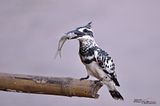Once in a while I get worried about all those images I took and still haven't put up in this blog. So here I am writing about photos of birds I took back in March this year. I barely updated my blog during March, only 5 posts to be exact, but I birded almost everyday and that made my hard disk full of photos I still haven't given a second look. Anyway, I've been trying to finish up all those images and today I've chosen to write about a particular set of photos I took from Mae Hia Agricultural College, a famous place for grassland birding in Chiang Mai. These photos are of the 2 very similar species of pipits, the Richard's and Paddyfield Pipit, which gave me headaches trying to figure out which is which. They even made me a pipit-person for a month before I came back to Japan where pipits are not nearly as easy to find as in Thailand.
I'll start off with the more interesting one, at least for me, the Richard's Pipit (Anthus richardi). Craig Robson described it in his Field Guide to the Birds of Thailand and South-East Asia as being "larger than Paddyfield; longer bill and tail, heavier breast-streaking" which, to be honest, none of which can actually be used to identify when you're birding in the field. Features like postures and voice are much more useful in my opinion, especially the latter. Richard's Pipit might normally have longer bill and tail with heavier breast-streaking like what Robson wrote in his book, but who would be able to know what exactly is longer or heavier. In fact, I've seen a few Richard's Pipits that have shortish bill and some Paddyfields that actually have a pretty long bill. So the main criteria that I choose to believe in is the voice.



The Richard's Pipit you're seeing here in this blog was identified by its flight call, which is much different from the Paddyfield's. I downloaded the call of both species and put them into my iPod, so whenever the bird flushed up and called, I quickly compared it to the mp3 files I have. The call of Richard's is much stronger and louder than Paddyfield's. It was actually not that difficult once you are familiar with their calls. However, it's extremely tricky and almost impossible to identify the two when they're on the ground, not calling, since the Richard's Pipit that I found actually looked more like a typical Paddyfield, with a quite shortish bill and the Paddyfield Pipit that I photographed below actually looked more like that typical, guidebook-type Richard's, with that striking long bill.



Quite luckily there was one more thing that I could use to help identify the birds, the courtship song. Since most resident birds in Thailand starts pairing up around March and the Paddyfield Pipit is a very common resident bird, while the Richard's is a scarcer winter visitor, so I can be pretty sure when I see a pair of pipits following each other around with one of them constantly sings its sweet song that they are Paddyfields. The one in the photo above was also singing as well. It was actually taken at my local patch in Mae Taeng. There were several pairs at Mae Hia too, but they were all too shy. Luckily, the other similar species, the Blyth's Pipit, is so rare in Thailand, that I can almost eliminate it from the possible candidates for the identification, though I really wish that it will actually pop up someday. Dave Bakewell of Dig Deep once found and nicely photographed one in Malaysia last year! I'm pretty sure that I'll be able to tell once I find it. I'm well-prepared!
















.jpg)

3 comments:
Well, they look the same to my (older than your) eyes!
Excellent photos and very good observation. I can never tell which is which. Richards pipit is a rare migrant so I assume that all pipits that I see here are paddyfields.
Super pictures of both species. Fortunately we don't have your problem too much here as Richard's is quite scarce and Paddyfield quite rare. But I'll keep your explanations in mind if I come across a big pipit.
Post a Comment